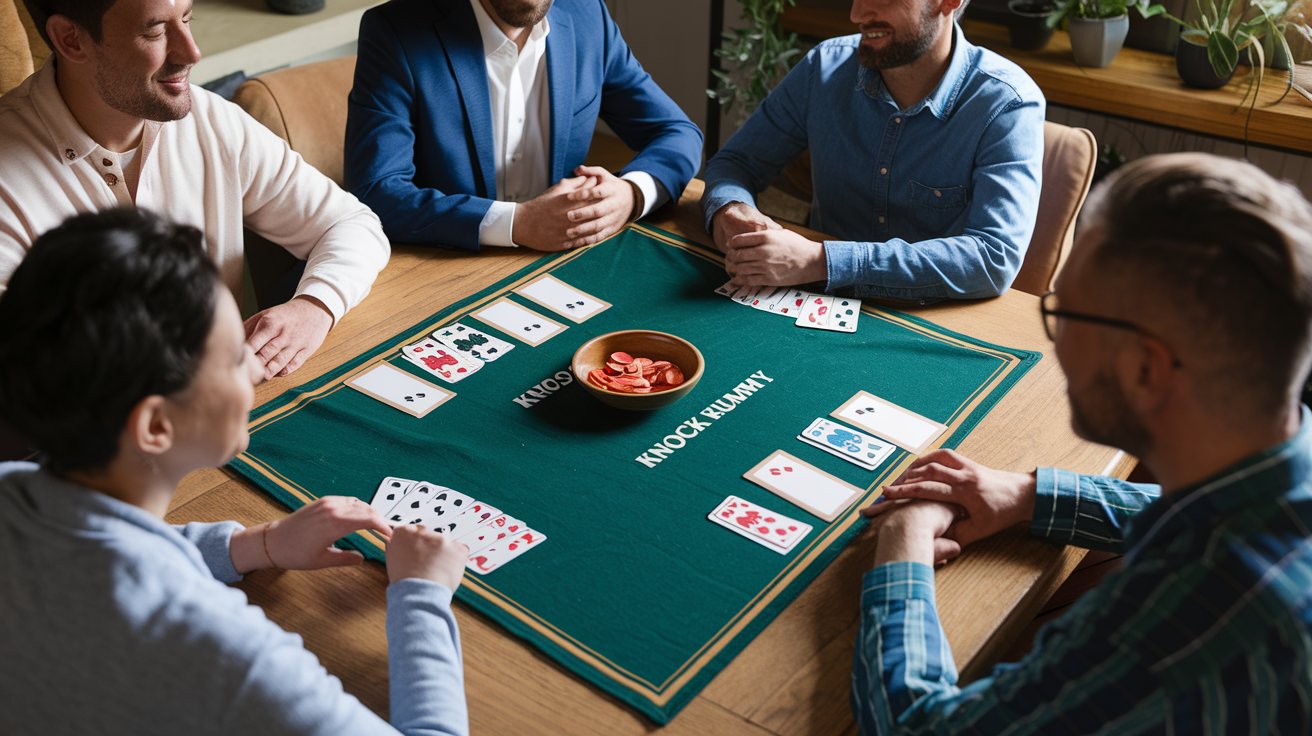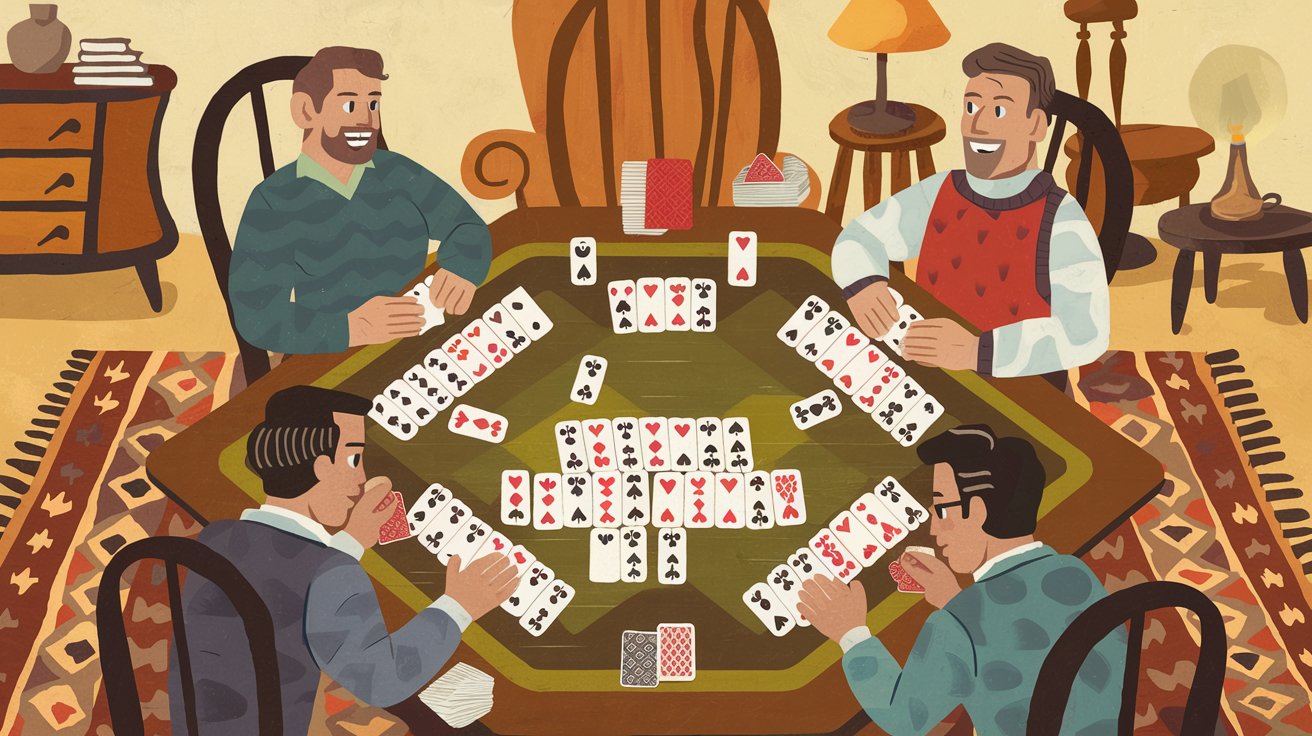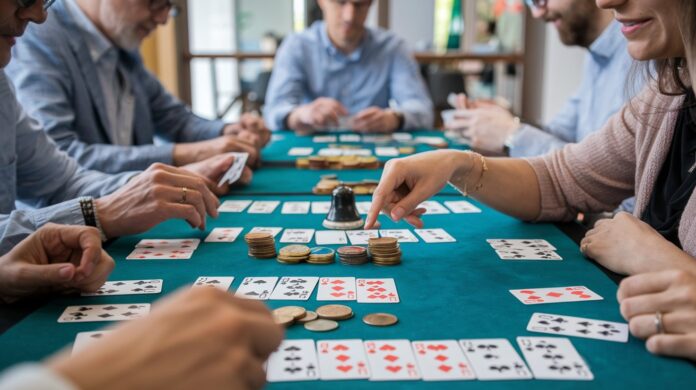Knock Rummy (also known as Gin Rummy Knock or simply Knock) is a delightful variation of traditional rummy that combines quick gameplay with strategic decision-making. If you enjoy card games but find traditional Gin Rummy a bit too complex or time-consuming, Knock Rummy offers the perfect balance of accessibility and challenge. This engaging twist on the classic formula introduces a “knocking” mechanism that creates exciting moments of tension and tactical choices that will keep players of all skill levels thoroughly entertained.
In this comprehensive guide, we’ll walk through everything you need to know about Knock Rummy—from basic setup to advanced strategies. Whether you’re hosting a game night with friends, looking for a fun family activity, or simply expanding your card game knowledge, you’ll find all the information you need to start playing this fantastic game right away.
What Is Knock Rummy?

Knock Rummy is a simplified version of Gin Rummy that maintains the core mechanics of forming melds (sets and runs) while introducing a strategic “knocking” element. Rather than requiring players to form their entire hand into valid combinations, Knock Rummy allows players to end the round when they have reduced their unmatched cards (called “deadwood”) to a certain value or less.
This variation speeds up gameplay while preserving the strategic depth that makes rummy games so enduringly popular. The game typically plays well with 2-4 players and strikes an excellent balance between luck and skill, making it appropriate for players of various ages and experience levels.
Equipment Needed
Before diving into the rules, let’s gather everything you’ll need to play Knock Rummy:
- Standard deck of 52 cards (no jokers)
- Scoring pad and pencil for tracking points
- Flat playing surface with enough room for each player to arrange their cards
- Optional: Card holders for younger players or extended gaming sessions
Basic Terminology
Understanding these key terms will help you grasp the rules more easily:
- Melds: Valid combinations of cards in your hand, which can be either sets or runs
- Sets: Three or four cards of the same rank (e.g., three 8s or four Queens)
- Runs: Three or more consecutive cards of the same suit (e.g., 5-6-7 of hearts)
- Deadwood: Cards in your hand that aren’t part of any meld
- Deadwood count: The total point value of your deadwood cards
- Knocking: Ending the round when your deadwood count is 10 or less
- Going Gin: Having no deadwood (all cards form valid melds)
Card Values
In Knock Rummy, cards have the following point values:
- Ace: 1 point
- Face cards (King, Queen, Jack): 10 points each
- Number cards (2-10): Face value (e.g., 7 of hearts = 7 points)
Setup and Dealing
Follow these steps to start your game of Knock Rummy:
- Choose a dealer: This can be done randomly by drawing cards (lowest card deals first).
- Shuffle thoroughly: The dealer shuffles the deck at least once.
- Deal cards: Each player receives 10 cards, dealt one at a time, face-down.
- Create the stock pile: Place the remaining cards face-down in the center of the table.
- Start the discard pile: Turn the top card of the stock pile face-up next to it to begin the discard pile.
- Arrange hands: Players should sort their cards by suit and rank to more easily identify potential melds.
Basic Gameplay

Now that everything is set up, let’s explore how to play:
Turn Sequence
On your turn:
- Draw a card either from the stock pile or the top card from the discard pile.
- Form or rearrange melds in your hand (mentally, not on the table).
- Discard one card face-up onto the discard pile to end your turn.
Forming Melds
In Knock Rummy, there are two types of valid melds:
Sets (also called “groups”):
- Three or four cards of the same rank but different suits
- Examples: three 7s, four Queens
Runs (also called “sequences”):
- Three or more consecutive cards of the same suit
- Examples: 4-5-6 of spades, 8-9-10-J of diamonds
- Aces can be high or low (can form A-2-3 or Q-K-A), but not both (can’t form K-A-2)
Knocking
The defining feature of Knock Rummy is the ability to “knock”:
- When your deadwood count is 10 points or less, you may end your turn by knocking (literally tapping the table, or simply announcing “knock”).
- After knocking, lay your cards face-up on the table, arranged into melds with deadwood separate.
- Your opponent(s) then lay down their cards, arranging them into melds.
- Opponents may lay off any deadwood cards that could extend your melds (for example, adding a fourth 8 to your set of three 8s).
Going Gin
A special case of knocking occurs when you have no deadwood:
- When all your cards form valid melds (deadwood count = 0), you may declare “Gin” instead of knocking.
- Lay down all your cards arranged into melds.
- In this case, opponents cannot lay off any cards.
Scoring
After someone knocks or goes Gin, points are calculated as follows:
If a player knocks:
- Calculate the difference between the knocker’s deadwood and each opponent’s deadwood
- If the knocker has lower deadwood, they score the difference
- If an opponent has equal or lower deadwood, they score the difference plus a 10-point bonus (called “underknocking”)
If a player goes Gin:
- They score 25 points plus the total value of all opponents’ deadwood
- There is no opportunity for opponents to lay off or underknock
Example Scoring Scenario:
- Player A knocks with 8 points of deadwood
- Player B has 15 points of deadwood after laying off
- Player A scores (15 – 8) = 7 points
- If Player B had only 5 points of deadwood, they would score (8 – 5) + 10 = 13 points for underknocking
Game Progression
Knock Rummy can be played in several ways:
- Set number of rounds: Play a predetermined number of deals
- Target score: Play until someone reaches an agreed-upon score (often 100 or 150 points)
- Time limit: Play for a set amount of time, with the highest scorer winning
The deal passes clockwise after each round, regardless of who won the previous hand.
Advanced Rules and Variations

As you become more familiar with the basic game, you might want to try these common variations:
Oklahoma Gin
This popular variation introduces a sliding knock value:
- The initial discard determines the maximum knock value
- If the initial discard is an ace through 5, the knock value equals the card’s value
- If the initial discard is 6 or higher, the knock value is 10
- This creates more dynamic gameplay as the knock threshold changes each round
California Knock
In this variation:
- The dealer has the option to “reject” the first card turned up
- If rejected, the next card is turned up and becomes the first discard
- The dealer must either accept or reject the first card before looking at their hand
- This adds an element of risk and reward to the dealer’s decisions
Hollywood Gin
This extended version is played to 250 points and includes:
- Bonuses for going Gin multiple times in a row
- Special bonuses for particular melds (like four of a kind)
- A “Big Gin” bonus for going Gin with 11 cards (rather than the standard 10)
Strategic Tips for Beginners
Ready to try your hand at Knock Rummy? These tips will help you develop a winning strategy:
Card Management
- Keep your hand flexible: In early stages, avoid committing too heavily to specific melds
- Watch the discard pile: Pay attention to which cards your opponents pick up or pass on
- Consider card proximity: Cards that are close in rank (like 7-9 of the same suit) have potential even with a gap
- Discard high cards early: Unless they’re already part of a meld, high-value cards are risky to hold
Knocking Strategy
- Knock opportunistically: Don’t always wait for the lowest possible deadwood
- Calculate risk vs. reward: Sometimes it’s better to knock with 8-10 points than to risk an opponent going Gin
- Consider your opponent’s hand: If they’ve been drawing from the stock pile for several turns, they might be far from knocking
Defensive Play
- Track discards: Remember which cards have been played to gauge what opponents might be collecting
- Safe discards: When possible, discard cards that you’ve seen your opponents discard
- Hold onto blocking cards: Sometimes it’s worth keeping a card that might complete an opponent’s run or set
Frequently Asked Questions
How does Knock Rummy differ from Gin Rummy?
While both games share the same basic mechanics, Knock Rummy typically allows knocking with up to 10 points of deadwood, while traditional Gin Rummy uses a lower threshold (usually 10 or less, with variations). Knock Rummy is generally considered more accessible and faster-paced.
Can I rearrange my melds after initially forming them?
Yes! Until you knock or the round ends, you can mentally rearrange your melds however you wish. Cards aren’t committed to specific melds until they’re laid on the table.
What happens if the stock pile runs out?
If no one has knocked by the time the last card is drawn from the stock pile, the round ends in a draw. No points are scored, and the deal passes to the next player.
Can the same card be part of both a run and a set?
No, each card can only be used in one meld. You’ll need to decide whether a card is more valuable as part of a run or a set.
Is Ace high or low in runs?
Aces can be used as either high (after King) or low (before 2), but not both in the same hand. For example, you could have A-2-3 or Q-K-A, but you couldn’t use the same Ace in both K-A and A-2.
Playing with Different Numbers of Players
While Knock Rummy is traditionally a two-player game, it adapts well to different player counts:
Three Players
When playing with three:
- Deal 7 cards to each player instead of 10
- The knock threshold remains at 10 points or less
- Scoring works the same way, with each player comparing their deadwood against the knocker’s
Four Players
For a four-player game:
- Deal 7 cards to each player
- Consider playing in partnerships (like Bridge)
- In partnership play, combine both partners’ deadwood when calculating scores
Etiquette and Social Aspects
Knock Rummy isn’t just about the rules—it’s also a social experience:
Game Etiquette
- Pace of play: Try to take turns in a reasonable amount of time
- Card handling: Avoid marking or bending cards
- Discarding: Place discards neatly so the pile is clear for all players
- Good sportsmanship: Remember that luck plays a significant role in card games
Teaching New Players
When introducing others to Knock Rummy:
- Start by explaining the objective before diving into specific rules
- Play a few “open hands” where all cards are visible for teaching purposes
- Be patient and offer strategic advice without taking over their decisions
- Emphasize the fun aspects rather than complex strategies initially
Why Knock Rummy Endures
There are several reasons why Knock Rummy remains popular:
- Accessibility: The rules are straightforward enough for most people to learn quickly
- Depth: Despite simple mechanics, the game offers considerable strategic depth
- Balance: It strikes a perfect balance between skill and luck
- Portability: All you need is a standard deck of cards
- Social interaction: The game encourages conversation and friendly competition
- Adaptability: House rules can easily adjust the game to suit different preferences
Conclusion
Knock Rummy offers a delightful twist on the classic rummy formula, creating a game that’s both accessible to newcomers and engaging for experienced card players. With its perfect blend of luck and strategy, quick gameplay, and exciting “knock” mechanic, it’s no wonder this variation has remained popular for generations.
Whether you’re looking for a casual two-player game for a rainy afternoon, a family-friendly card game that players of different ages can enjoy together, or simply want to expand your repertoire of card games, Knock Rummy delivers hours of entertainment with minimal setup.
So gather your friends or family, shuffle up a deck of cards, and enjoy this wonderful blend of strategy, skill, and chance. Remember that like any card game, Knock Rummy becomes more enjoyable as you gain experience, develop your own strategies, and create memorable moments around the table. Happy knocking!

Zareb Saleh is a journalist at Gulf Today and a ghostwriter for Gameoholic, specializing in gaming, technology, and digital culture. With a keen eye for industry trends, he delivers insightful stories that engage and inform readers.




